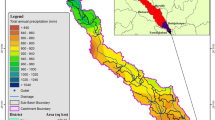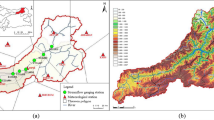Abstract
Accurate and reliable streamflow forecasting is paramount in the field of water resource planning and management, especially in semi-arid regions. However, streamflow time series are highly complex and non-linear in nature; traditional or physical-based models may fail to capture the complexity and maintain the robustness of the datasets. Therefore, the present study aims to improve the forecasting accuracy and reduce the uncertainty in the datasets by using the data-driven approach such as artificial neural network (ANN) that can efficiently handle the non-linearity in the large and complex hydrological data. This study method includes two steps: i.e., first to develop the ANN models using different combinations of inputs such as rainfall, temperature, and streamflow lag by one or two and then to validate the developed models to forecast the streamflow by using a total of four performance evaluation indices such as correlation coefficient (R), root mean square error (RMSE), modified Nash-Sutcliff efficiency (MNSE), and modified index of agreement (MIA). The proposed method is demonstrated in Jakham reservoir located in Pratapgarh district, Rajasthan, India, for improving the accuracy of monthly streamflow forecasting over a 40-year period (1975–2015). We found that increasing the number of input parameters improves the accuracy of the model and enhance its performance. According to the results, the ANN models 5 and 6 (M5 and M6) showed significant variation in the performance evaluation criteria. This clearly indicates that ANN model with an input combination of lag one or two streamflow (i.e., model M5 and M6) is performed better when compared to a model that incorporates only monthly rainfall and monthly lag one or two rainfall as inputs. Overall, the application of ANN models M5 and M6 (with lag one and two streamflow as an input) can forecast monthly streamflow forecasting with better accuracy.





Similar content being viewed by others
References
Adeyemo J, Oyebode O, Stretch D (2018) River flow forecasting using an improved artificial neural network. In: Tantar AA, Tantar E, Emmerich M, Legrand P, Alboaie L, Luchian H (eds) EVOLVE - A Bridge between Probability, Set Oriented Numerics, and Evolutionary Computation VI. Advances in Intelligent Systems and Computing, Springer, Cham. vol 674. https://doi.org/10.1007/978-3-319-69710-9_13
Agarwal A, Singh RD, Mishra SK, Bhunya PK (2005) ANN - based sediment yield models for Vamsadhara river basin (India). Water S A 31(1):95–100
Aichouri I, Hani A, Bougherira N, Djabri L, Chaffai H, Lallahem S (2015) River flow model using artificial neural networks. Energy Procedia 74:1007–1014
Al-Saati NH, Omran II, Salman AA, Al-Saati Z, Hashim KS (2021) Statistical modeling of monthly streamflow using time series and artificial neural network models: Hindiya Barrage as a case study. Water Pract Technol 16(2):681–691
Ali S, Shahbaz M (2020) Streamflow forecasting by modeling the rainfall–streamflow relationship using artificial neural networks. Model Earth Syst Environ 6(3):1645–1656
Apaydin H, Sattari MT, Falsafian K, Prasad R (2021) Artificial intelligence modelling integrated with singular spectral analysis and seasonal-trend decomposition using loess approaches for streamflow predictions. J Hydrol 600: 126506
Asadi H, Shahedi K, Sidle JB, RC, (2019) Rainfall-runoff modelling using hydrological connectivity index and artificial neural network approach. Water 11(2):212
Chang FJ, Chang LC, Huang HL (2002) Real-time recurrent learning neural network for stream-flow forecasting. Hydrol Process 16(13):2577–2588
Dostdar H, Aftab A (2020) Machine learning techniques for monthly river flow forecasting of Hunza River, Pakistan. Earth Sci Inform 13:939–949. https://doi.org/10.1007/s12145-020-00450-z
Dibike YB, Solomatine DP (2001) River flow forecasting using artificial neural networks. Phys Chem Earth (b) 26:1–7
Ebtehaj I, Bonakdari H (2013) Evaluation of sediment transport in sewer using artificial neural network. Eng Appl Comput Fluid Mech 7(3):382–392
Ebtehaj I, Bonakdari H, Zaji AH, Gharabaghi B (2020) Evolutionary optimization of neural network to predict sediment transport without sedimentation. Complex Intell Syst 7(1):401–416
Edossa DC, Babel MS (2012) Forecasting hydrological droughts using artificial neural network modeling technique, South Africa: University of Pretoria, Proceedings of 16th SANCIAHS National Hydrology Symposium
Othman F, Naseri M (2011) Reservoir inflow forecasting using artificial neural network. Phys Sci Int J 6(3):434–440
Ghazi B, Jeihouni E, Kalantri Z (2021) Predicting groundwater level fluctuations under climate change scenarios for Tasuj plain. Iran Arab J Geosci 14:2
Jain SK, Agarwal PK, Singh VP (2007) Hydrology and water resources of India. Springer, The Netherlands, p 592
LeCun Y, Bengio Y, Hinton G (2015) Deep learning. Nature 521(7553):436
Kalteh AM (2013) Monthly river flow forecasting using artificial neural network and support vector regression models coupled with wavelet transform. Comput and Geosci 54:1–8
Kişi Ö (2008) River flow forecasting and estimation using different artificial neural network techniques. Hydrol Res 39(1):27–40
Köppen W, Wegener A (1924) Die Klimate der Geologischen Vorzeit. Gebr. Borntraeger, Berlin, Stuttgart
Machiwal D, Jha MK (2003) Optimal land and water resources allocation using stochastic linear programming. In: Singh P Vijay; Yadava Ram Narayan. Water Resources System Operation: Proceedings of the International Conference on Water and Environment (WE-2003), December 15–18, Bhopal, India. Allied Publishers, 5: 264–275
Machiwal D, Jha MK (2015) GIS-based water balance modeling for estimating regional specific yield and distributed recharge in data-scarce hard-rock regions. J Hydro-Environ Res 9(4):554–568
Mazrooei A, Sankarasubramanian A, Wood AW (2021) Potential in improving monthly streamflow forecasting through variational assimilation of observed streamflow. J Hydrol 600: 126559
Masselot P, Dabo-Niang S, Ouarda CF, TB, (2016) Streamflow forecasting using functional regression. J Hydrol 538:754–766
Mehr AD, Kahya E, Şahin A, Nazemosadat MJ (2014) Successive-station monthly streamflow prediction using different artificial neural network algorithms. Int J Environ Sci Technol 12(7):2191–2200
Mins AW, Hall MJ (1996) Artificial neural network as a rainfall runoff models. Hydrol Sci J 41(3):399–417
Mohammadi K, Eslami HR, Dardashti SD (2005) Comparison of regression, ARIMA and ANN models for reservoir inflow forecasting using snowmelt equivalent (a case study of Karaj). J Agric Sci Technol 7:17–30
Mulia EI, Asano T, Tkalich P (2015) Retrieval of missing values in water temperature series using a data-driven model. Earth Sci Inform 8:787–798
Muhammad Adnan R, Yuan X, Kisi O, Yuan Y, Tayyab M Lei X (2019) June. Application of soft computing models in streamflow forecasting. In Proceedings of the institution of civil engineers-water management 172(3): 123–134. Thomas Telford Ltd.
Nagy HM, Watanabe K, Hirano M (2002) Prediction of sediment load concentration in rivers using artificial neural network model. J Hydr Eng 128:588–595
Noori N, Kalin L (2016) Coupling SWAT and ANN models for enhanced daily streamflow prediction. J Hydrol 533:141–151
Poonia V, Tiwari HL (2020) Rainfall-runoff modeling for the Hoshangabad Basin of Narmada River using artificial neural network. Arab J Geosci 13(18):1–10
Rahman SA, Chakrabarty D (2020) Sediment transport modelling in an alluvial river with artificial neural network. J Hydrol 588: 125056
Rezaeian-Zadeh M, Tabari H, Abghari H (2013) Prediction of monthly discharge volume by different artificial neural network algorithms in semi-arid regions. Arab J Geosci 6:2529–2537. https://doi.org/10.1007/s12517-011-0517-y
Sharma P, Bhakar SR, Ali S, Jain HK, Singh PK, Kothari M (2018) Generation of synthetic streamflow of Jakham River, Rajasthan using Thomas-Fiering model. J Agric Eng ISAE 55(4):47–56
Sharma P, Machiwal D (2021) Streamflow forecasting: overview of advances in data-driven techniques. In: Sharma P, Machiwal D (eds) Advances in streamflow forecasting: from traditional to modern approaches. Elsevier, pp 1–50
Sharma P, Machiwal D, Jha MK (2019) Overview, current status, and future prospect of stochastic time series modeling in subsurface hydrology. In: Viswanathan PM, Chung SY (eds) Venkatramanan S. GIS and Geostatistical Techniques for Groundwater Science, Elsevier, pp 133–151
Sharma P, Singh S, Sharma SD (2021) Artificial neural network approach for hydrologic river flow time series forecasting. Agric Res pp 1–12. https://doi.org/10.1007/s40003-021-00585-5
Sinha J, Sahu, RK, Agrawal A, Pali AK, Sinha BL (2013) Rainfall runoff modelling using multi layer perceptron technique – a case study of the upper Kharun. J Agril Eng 50(2): 43–51
Sudheer KP, Nayak PC, Ramasatri KS (2003) Improving peak flow estimates in artificial neural network river flow models. Hydrol Process 17:677–686. https://doi.org/10.1002/hyp.5103
Sudheer KP, Jain A (2004) Explaining the internal behaviour of artificial neural network river flow models. Hydrol Process 18:833–844
Tokar AS, Johnson PS (1999) Rainfall modeling runoff using artificial neural network. J Hydr Eng ASCE 4(3):232–239
Uzlu E, Akpınar A, Özturk HT, Kankal NS, M, (2014) Estimates of hydroelectric generation using neural networks with the artificial bee colony algorithm for Turkey. Energy 69:638–647
Veintimilla-Reyes J, Cisneros F, Vanegas P (2016) Artificial neural networks applied to flow prediction: a use case for the Tomebamba river. Proc Eng 162:153–161. https://doi.org/10.1016/j.proeng.2016.11.031
Vilanova RS, Zanetti SS, Cecílio RA (2019) Assessing combinations of artificial neural networks input/output parameters to better simulate daily streamflow: case of Brazilian Atlantic Rainforest watersheds. Comput Electron Agric 167: 105080
Wagena MB, Goering D, Collick AS, Bock E, Fuka DR, Buda A Easton ZM (2020) Comparison of short-term streamflow forecasting using stochastic time series, neural networks, process-based, and Bayesian models. Environ Model Softw 126: 104669
Yaseen ZM, El-shafie A, Jaafar O, Afan HA, Sayl KN (2015) Artificial intelligence based models for stream-flow forecasting: 2000–2015. J Hydrol 530:829–844. https://doi.org/10.1016/j.jhydrol.2015.10.038
Yaseen ZM, Jaafar O, Deo RC, Kisi O, Adamowski J, Quilty J, El-Shafie A (2016) Stream-flow forecasting using extreme learning machines: a case study in a semi-arid region in Iraq. J Hydrol 542:603–614
Yonaba H, Anctil F, Fortin V (2010) Comparing sigmoid transfer functions for neural network multistep ahead streamflow forecasting. J Hydrol Eng (ASCE) 15(4):275–283
Zhang Z, Zhang Q, Singh VP (2018) Univariate streamflow forecasting using commonly used data-driven models: literature review and case study. Hydrol Sci J 63(7):1091–1111
Author information
Authors and Affiliations
Corresponding author
Ethics declarations
Ethical approval
This article does not contain any studies with human participants or animals performed by any of the authors.
Conflict of interest
The authors declare no competing interests.
Additional information
Responsible Editor: Broder J. Merkel
Rights and permissions
About this article
Cite this article
Sharma, P., Madane, D., Bhakar, S.R. et al. Monthly streamflow forecasting using artificial intelligence approach: a case study in a semi-arid region of India. Arab J Geosci 14, 2440 (2021). https://doi.org/10.1007/s12517-021-08778-6
Received:
Accepted:
Published:
DOI: https://doi.org/10.1007/s12517-021-08778-6




